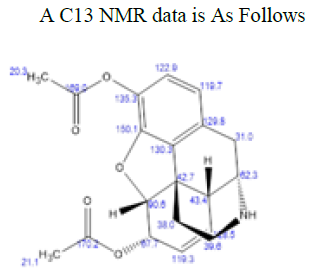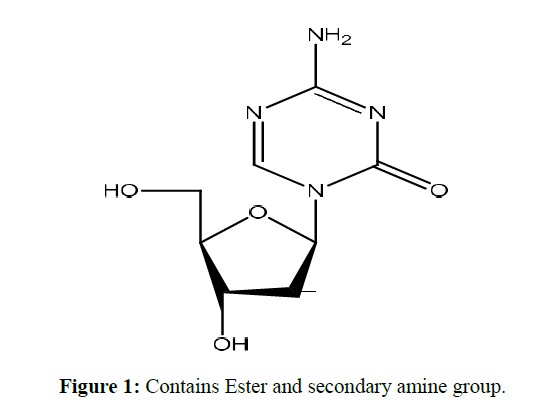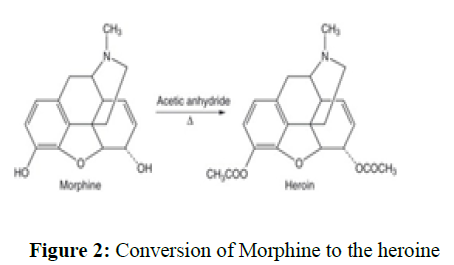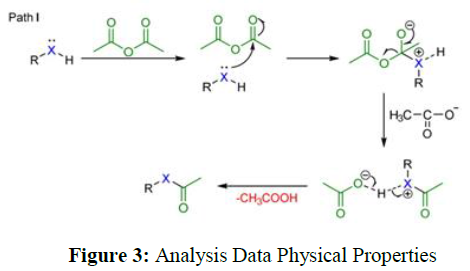Review Article - Der Pharma Chemica ( 2021) Volume 13, Issue 11
Chemistry of Opioids
Kanak Pandita*, Hiteshu Janib, Pritesh Sharmac and Neha MishraKanak Pandita, Department of Engineering and Technology, Mumbai University, Mumbai, India, Email: kanakpandit17@gmail.com
Abstract
Opioids are a group of organic compounds in which it contains tertiary amine and ester group which have their effects on the central nervous system which is responsible for the happiness or relieving pain. In many parts of the world, people are seen using such narcotic group of drugs. In this paper, a brief history of opioids such as heroin, its synthesis and the mechanism involved in this reaction is given. The reaction involved in synthesis could be of name reaction or certain parameter involved in synthesizing the molecule.
https://betist.fun https://betlike.fun https://betmatik.fun https://betpark.fun https://bettilt.club https://elexbet.fun https://extrabet.fun https://hepsibahis.fun https://kingbetting.fun https://maksibet.fun https://marsbahis.xyz https://matadorbet.fun https://pulibet.fun https://restbet.fun https://milanobet.fun https://supertotobet.fun https://vevobahis.fun https://imajbet4.com https://maltcasinocu.fun https://sekabetgiris.fun
Keywords
Pharmacology, Immune System, heptahelical, tertiary amine, Hydromorphone.
Introduction
Opioids are recreational drugs that are consumed for inducing happiness and relieving pain. Since it has dangerous effects on our body, it comes under the class of narcotic drugs. These drugs when consumed interacts with the heptahelical receptors or group of G protein-coupled receptors which we can also call opioid receptors. Opioids are known to have a considerable effect on the immune responses of our body and reduce the efficacy of immunity in our body(immunosuppression) thereby decreasing the proliferation of cells and leading to neurogenesis (the production, growth and development of nervous system cells [1]. There are three major opioid receptors in the brain: mu, kappa, and delta.
Literature Review
General Information on Opioids
Opioids are a group of organic compounds in which it contains tertiary amine and ester group which have their effects on the central nervous system which is responsible for the happiness or relieving pain. Opioids are a wide range of medications that belongs to the natural plant alkaloids found in opium that are obtained from the resin of opium poppy. Opioids are majorly used to minimize the pain that is they work as narcotic analgesics. Opioids come among the most potent analgesics that are recently accessible [2]. These opioids are the class of pharmacologic agents and come under the vast ordnance of the repeating approaches to the management of pain
There are three major types of opioids which includes:
Opiates are accessed from nature, include Codeine, morphine, heroin, and heroin metabo- lite. The next category is semi-synthetic opioids which have Hydrocodone, Hydromorphone, oxycodone, and oxymorphone. Synthetic Opioids consist of Fentanyl and Fentanyl analogs, meperidine, methadone, propoxyphene, tramadol, and tapentadol. Buprenorphine, nalox- one, and naltrexone are the drugs that are loosely termed opioids. Opioids work by interact- ing with the opioids receptors present in the cell, relieves the pain of the person subjected to it. The Central, peripheral nervous system and gastrointestinal tract are the spots where these opioid receptors are present. Ingestion, Inhalation, Injection through syringes, and smoking are the ways by which one consumes these opioids [3]. For the treatment of chronic pain, opioids largely used, which leads to a great risk of addiction to opioids. These Opioids have G-protein receptors, act accordingly. Central and Peripheral opioids receptors react with the agonist. The mode of communication between these opioids receptors and the agonists is through signaling that includes Gi/o coupling, Camp inhibition, and Ca++ channel inhibition [4].
These Opioids are massively used to reduce pain so the basic function of these opioids to tell the brain that an individual is not in pain. Pain initiated through surgery or an injury can be healed with the help of opioids. This makes the use of opioids on a large scale while dealing with the pain of cancer and back pain or osteoarthritis. This makes an individual vul- nerable to the addiction of opioids and leading to dependence on it. Stating the fact that out of four people taking the opioids support for revealing their pain, one becomes addicted to it for long period. This in turn shows many side effects in an individual like increased physical dependence, tolerance, depression followed by confusion, constipation, nausea, itching and sweating etc. Increased consumption of different opioids can stop an individuals breathe and can be fatal. The involvement of benzodiazepines is prominently seen in the prescrip- tion overdosing opioids deaths. These benzodiazepines are the central nervous depressant, incudes sleep, reduces anxiety, and prevent seizures [5]. When an individual abruptly stops the intake or is being forcibly done can change his or her mood as they feel anxiety,agitation, muscle aches and tremors. This addiction and vast use of opioids lead to the smuggling of these products on a commercial scale, so all this takes a step forward of opioids abuse and drug diversion.
This dependence on the prescription of opioids for medical usage and incre- ment in the addiction to it also the physical dependence as proved very dangerous and is now considered as a concern on a national level. Overdosing of opioids and continuous intake of this drug makes the brain to work more or less when the intake of drug is on but works abruptly in a strange way when the drug is absent in the body. This abuse of Opioids also has the potential to disturb a person’s life like it adversely affects the relationship, physical well-being of a person and can also stress the mental health of the individual. To overcome this addiction people are advised to do exercise, acupuncture, and include the use of herbs in their daily life.
Heroin
Heroin is an alkaloid and a synthetic diacetyl derivative of morphine. Heroin is chronic and the effects are devastating. It particularly has a high relapse rate because of producing a state of intense happiness.
The brain stem which consists of the midbrain, pons and medulla oblongata has a large number of opioid receptors. Therefore, the brain stem is affected by such drugs. The consequences of heroin are mainly related to breathing, respiratory depression and other respiratory problems as the respiratory system is connected to the brain stem. It also affects the nervous system, urinary system and leads to cardiovascular breakdown. These drugs are known to transform the structure of the brain which results in numerous signs and symptoms like sweating, vomiting, lack of appetite, slow breathing, depression, kidney diseases, arthritis, compulsive scratching, shallow breathing, dry mouth, mood swings, etc. When a person overdoses on heroin, the brain doesn’t receive enough oxygen that can kill the brain cells which can lead to loss of life. At times, the breathing stops and that can form a reason for death. Another case that can arise out is “hypoxia” where the oxygen level is inadequate at a tissue level. Such a situation can cause the victim to go into a state of coma or suffer from permanent brain damage.
The biggest side effect of this drug is addiction. The opioid receptors become so much habituated to the drug consumed that it stays in normal condition only during drug con- sumption. This even causes craving. So whenever, a victim chooses to give up such an addiction, he can suffer from Opioid Use Disorder (OUD). Opioid use disorder is a chronic condition where the victim goes into a state of relapse, suffering from pessimism due to drug abstinence. This often compels the victim back to consume drugs. For relieving the person from pain, methadone is the best opioid agonist prescription. Buprenorphine and naltrexone act as a partial agonist and opioid antagonist respectively against such drugs. There arises a situation when a victim develops tolerance towards drugs i.e. there is a lack of responsiveness due to overconsumption of such drugs. So, to release endorphins, they increase their drug consumption even more. That can deteriorate the health of the person even more.
Experimental
In this Section synthesis and analysis of heroin is written.
In this step, morphine diacetylation takes place in presence of acetic anhydride, this reaction takes place in absence of water. In this step, 2.5gm of Morphine is heated with acetic anhydride till the entire solution becomes colourless and finally, the product is dumped in the water as water being inorganic solvent heroin precipitates out and its crystallisation is done by using alcohol.
Mechanism
The Oxygen is nucleophilic in the Hydroxy group where it attacks the electrophilic car- bonyl group of acetic anhydride and a by-product of this reaction is acetic acid. Both hydroxyl groups are acetylated with two moles of acetic anhydride.
| Boiling Point | 912.45 [K] |
| Melting Point | 687.08 [K] |
| Critical Temperature | 910.15 [K] |
| Critical Pressure | 19.61 [Bar] |
| Critical Volume | 968.5 [cm3/mol] |
| Gibbs Energy | -158.35 [kJ/mol] |
| Log P | 1.02 |
| MR | 95.15 [cm3/mol] |
| Henry’s Law | 10.73 |
| Heat of Form | 638.88 [kJ/mol] |
| tPSA | 73.86 |
| CLogP: | 1.0338 |
| CMR: | 9.3462 |
| LogS: | -2.976 |
| PKa: | 8.644 |

| Signal | Type Of Carbon |
| 2.0 ppm | Broad Singlet |
| 6.60-6.74 | Aromatic Protons Singlet |
| 2.28 ppm | Methyl adjacent to carbonyl singlet |
| 5.22 | Hydrogen adjacent to ether |
| 5.59 | Vinyl Proton |
Conclusion
Heroin reaches the brain quickly and binds to opioid receptors on cells throughout the brain, especially those involved in pain and pleasure, as well as heart rate, sleep, and breathing regulation. Heroin is an opioid drug. It has adverse effects on the health as it causes hepatitis, HIV, AIDS, Fetal effects and also increases criminal violence. Heroin comes un- der narcotic drugs and is extracted from the opium poppy. Heroin came into existence by acetylation of morphine and was identified as hydrochloride of diacetylmorphine. Heroin is found in black, brown, white colours. Heroin is a derivative of morphine and is easily ob- tained by adding acetyl chloride or acetic anhydride to morphine. Heroin has many different names like diacetyl- morphine, acetylated morphine, morphine diacetate, etc. As heroin gives an experience of excitement and intense happiness it is therefore widely used for recreational purposes. C.R. Alder Wright was the first person to extract heroin from the opium poppy in the year 1874. It is mainly given passed through veins with the help of injection whereas various process for intaking heroin includes smoking or inhalation.
The molecular formula of Heroin is C21H23NO5 and its molecular weight 369.4 and contains two acetyl groups on O-3 and the O-6 position of the molecule. The physical and chemical properties of Heroin includes formal is zero, Isotope Atomic count is also zero, the defined stereocenter in the compound are five, whereas the covalently bonded unit present in the compound is one and the compound is also Canonicalized. The Experimental properties include if made exposed to air for a long time it turns pink. It is an Odourless compound but when air exposure is increased emits an acetic odour, also a bitter taste and it remains for three years from the date of manufacture if stored in recommended conditions. The usage of heroin healing severe pain in surgical procedures and healing the pain in the terminally ill
Future Scope
After noting down the ill-effects of the opioids on the human body, it has become a dire need to eradicate drug trafficking in order to cease the use of drugs. For this, biosensors have been a boon as they can easily get triggered on finding out there is a drug near it. There is a rapid development taking place around the world when it comes to the approaches related to immunoassay that includes piezoelectricity, micromechanics, electrochemistry, aptamer, etc. To describe on biosensors in short, they are highly specific, completely automatic, versatile and they are cheap. International Union of Pure and Applied Chemistry (IUPAC) states that biosensor is “an independently integrated receptor transducer device, which is capable of providing selective quantitative or semi-quantitative analytical information using a biological recognition element.
The biosensor has an inbuilt two parts: A chemical reception which gets triggered on sensing opioids followed by a transducer built in series which is responsible for the revelation of the opioids. The biosensors follow a principle of multianalyte monitoring. The mechanism of this biosensor is as follows: The molecular mass of opioid less than a thousand daltons will lead to the formation of immunocomplex which is the combination of antibody and antigen on the transducer surface. During the process of formation of complex, the mass, optical and electrochemical properties of transducer is unchanged. The receptor identifies the biochemical nature of the analyte concentration and generates a signal that is identified by transducer.
Now-a-days, efforts are being made to measure mass in the fluids with femtogram resolution using Resonant Mass Measurement (RMM) technique. Narcotics have a lower vapor pressure in comparison to other drugs. This encourages the development of the term known as ‘sensitivity’ of devices. High sensitivity of devices enhances the chances of detection of the opioids. Also, the devices must be small in size and light weight. The airports are also adopting new technologies to combat smuggling. Trace portal machine and drug detection kits come in handy to detect drugs and catch smugglers easily. SABRE 5000, an ion mobility spectrometer, is a cost-effective device used to identify narcotics in less time. Also, it is highly specific as well as portable.
Conflict of Interests
The author declared that, having no conflict of interests
Acknowledgements
The authors are thankful to the Meerut Institute of Engineering and Technology for providing the infrastructure and support for completion of this project. This work was also supported by the Molexus. Our profound gratitude is expressed to Mr. René Thomsen for providing the academic License of MVD software used for Docking. We acknowledge ChemAxon Ltd. (www.chemaxon.com) for the academic license agreement. ADMET properties were studied by the help of SwissADME and ProTox-ll.






